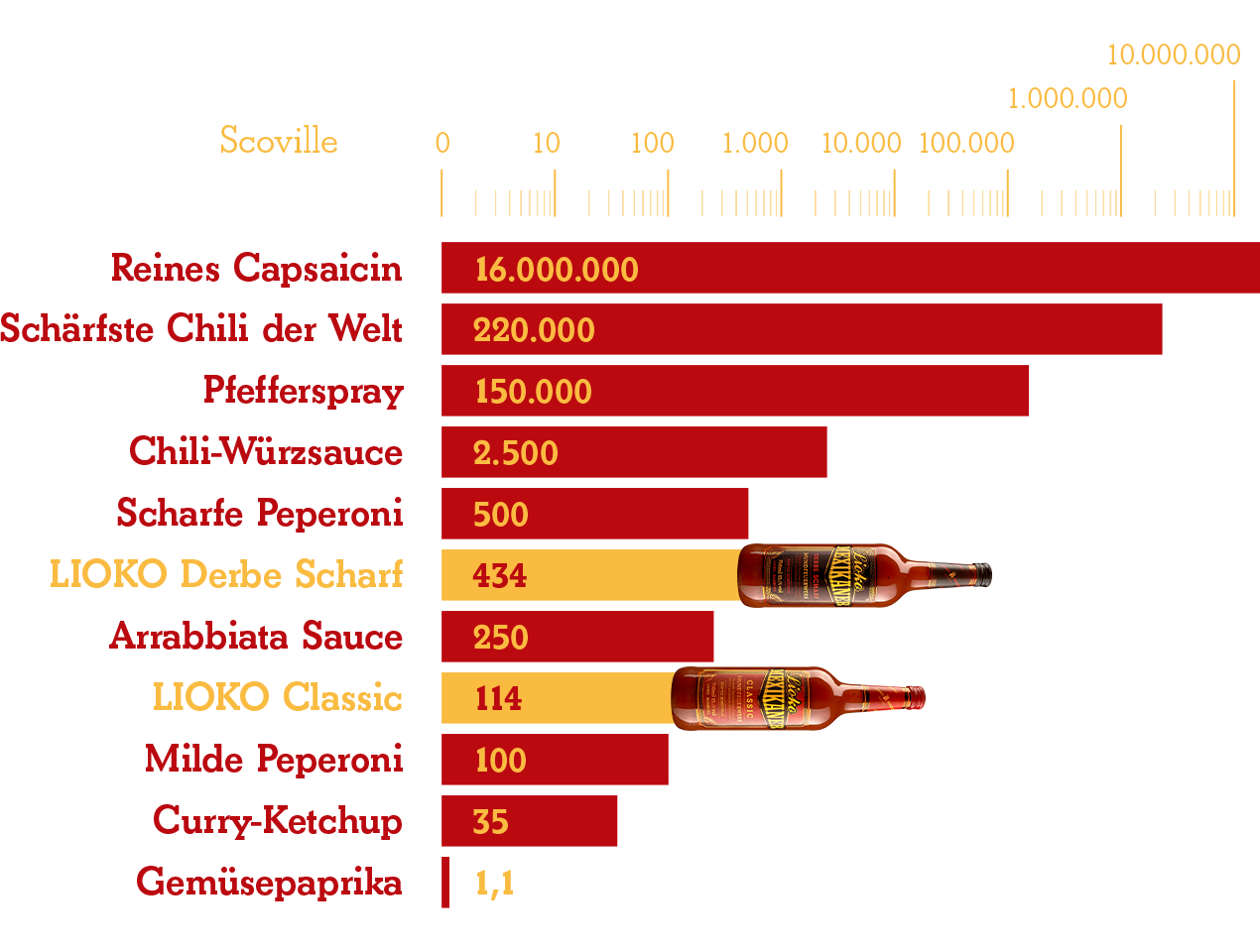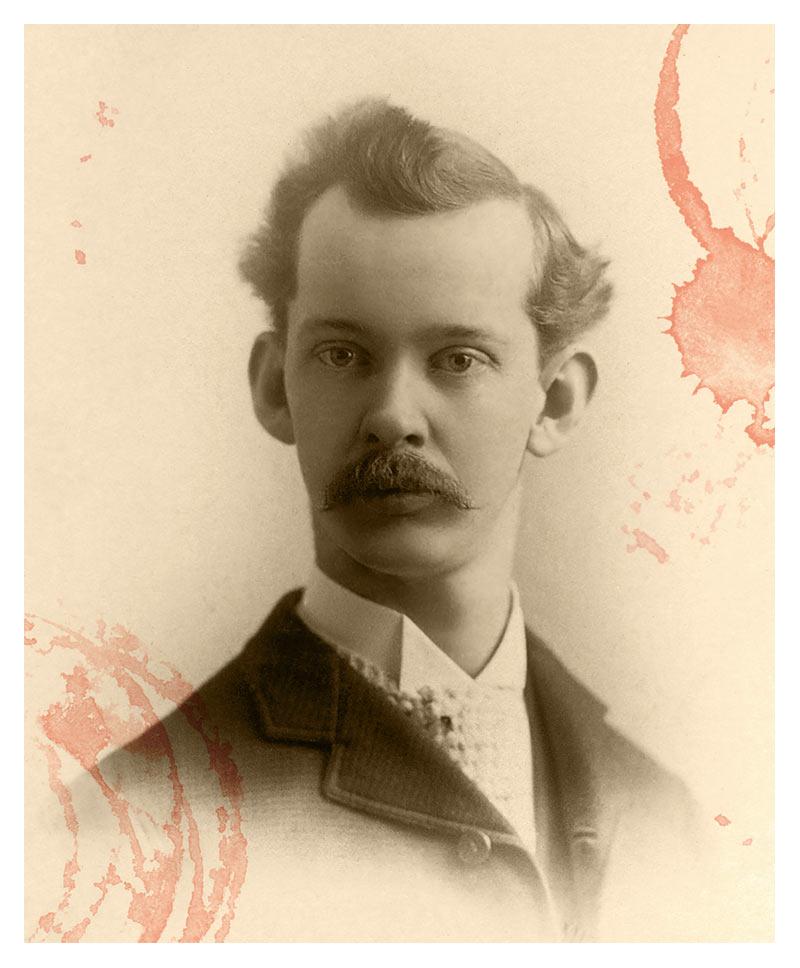Hotness
Fun facts and wise sayings all about the topic 'hotness'
How hot is Lioko Mexikaner?
Using the HPLC measuring method (learn more further down) that only measures hotness from chilis (capsaicinoids) the results are the following values:
Lioko Mexikaner CLASSIC: 114 Scoville (SHU)
Lioko Mexikaner DERBE SCHARF: 434 Scoville (SHU)
For the true experience the other components pepper and alcohol have to be taken in consideration.

Science is definitly not my strength! How do I read this damned diagram?
This wonderful graphic is scaled logarithmically*. And to put it simple, that means: Moving from one section between the larger dashes further right to the next section, the range of values is 10 times larger than in the previous section. Conversely, this means that the section between two smaller dashes corresponds to the previous section between two larger dashes. And to put it even more simple: On the far left you are looking with a magnifying glass and on the far right with binoculars. Cool, huh?
The advantage of this way of displaying is that many different scales can be represented. In our case, we want to see the differences between 100 and 114, and at the same time we want to show 16,000,000. All this is possible with this sweet logarithmic diagram.
*For nerds: Strictly speaking, it is a 'decadic' logarithmic scaling. As you nerd know, this means that we used 10 as the base of the logarithm for scaling.
Where does the hotness come from in Lioko Mexikaner?
Lioko Mexikaner combines tree different types of hotness:
1. chilis (capsaicinoids)
2. pepper (piperin)
3. alcohol
Fun fact: There are many chemical substances that trigger the feeling of sharpness. Capsaicin is just one of these substances and belongs to the group of capsaicinoids.
Capsaicinoids are different molecules that trigger the feeling of hotness in mammals and are found in chilies (capsicum). The most important capsaicinoids are capsaicin and dihydrocapsaicin. In addition to these two, there are a number of other substances that meet the criteria "hot" and "occurs in chili". However, these are less hot than their best-known colleagues and are found in smaller quantities in chilies.
Piperine is the heat carrier in pepper. Fun fact: Piperine is known of losing hotness under the influence of light.
Why does hotness burn so much? Is it dangerous?
That's because capsaicinoids stimulate the same receptors that detect heat or chemical stress, tricking our brains into thinking it's experiencing intense heat and pain. There is a prolonged desensitization of the nerves. Our body reacts to this irritation with increased blood flow and the release of endorphins, the body's own opioids. These in turn have an analgesic effect and trigger feelings of happiness (the "pepper high"). Caution: This can be addictive!
The oral intake of chillies and other hot foods is not harmful to health as long as you stay within the limits of the well-known hot foods in the world. On the contrary, if you consume spicy food regularly, you can tolerate it better. This probably means that drinking Lioko Mexikaner helps!
What can I do to stop my mouth from burning?
Drink fatty liquids like milk, kefir or a delicious mango lassi. Alternatively, you can rinse your mouth with cooking oil.
Fun fact: Capsaicin is soluble in both fat and alcohol. Therefore alcohol can also be helpful. Aqueous liquids are not suitable, since neither capsaicin nor piperine are easily dissolved in water. Only the sharpness of the alcohol can be washed away with water.
How do you measure sharpness?
To answer that, we have to go back a few decades to the great inventions and to a man who developed one of the most important achievements in the field of pungency: the pharmacologist Wilbur L. Scoville (1865-1942). Not only did this man have an impressive mustache, but in 1912 he invented a test for measuring hotness that he himself dubbed the Scoville Organoleptic Test. To this day, the spiciness of food products is indicated using the Scoville scale.
Back then, Wilbur soaked chilies in alcohol to dissolve the capsaicin. Then he proceeded as follows to measure the sharpness: He diluted the chili solution with water until a test person could no longer perceive the sharpness. The scale ranges from sweet peppers with zero Scoville to pure capsaicin with 16 million Scoville. So you need 16 million drops of water on one drop of capsaicin to stop feeling the heat.
Another important unit of measure is the American Spice Trade Association (ASTA). This unit is used to show then results of an analysis with an HPLC (high performance liquid chromatography). An HPLC measures the concentration of different capsaicinoids in a substance. The determined concentrations are then weighted according to their known heat effect and can be more or less easily converted into Scoville.

Wilbur L. Scoville, 1910